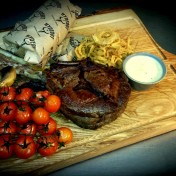Food costs to take larger bite of restaurant profits in 2019

Rising Food Cost in 2019
Find the ingredients to overcoming revenue challenges
BIRMINGHAM, AL, US, November 12, 2018 /EINPresswire.com/ -- With disposable income largely dictating the frequency with which people dine out, menu prices are critical in enticing someone to choose one restaurant over another.
Of course, other aspects – food quality and service, to name a couple – factor into the overall dining experience. But if the cost puts too much of a squeeze on their wallets, they’ll quickly seek other options or simply dine at home.
The urge to resist raising prices or making other potentially adverse operational changes will perhaps be no more difficult for owners and managers than in 2019. That’s because prices for all sorts of ingredients are going up.
In general, food-away-from-home, as the U.S. Department of Agriculture’s Consumer Price Index dubs restaurants and other places where consumers dine, is expected to continue its consistent rate of overall growth and to rise between 2 and 3 percent in 2019.
Specific items that will take a hit:
• Beef and veal, increase between 1.5 and 2.5 percent
• Pork, increase as much as 0.25 percent
• Poultry, increase between 1 and 2 percent
• Dairy, increase between 3 and 4 percent
• Fresh fruits, increase between 2 and 3 percent
• Cereals and bakery goods, increase 2.5 to 3.5 percent
• Non-alcoholic beverages, increase as much as 0.75 percent
The problem for restaurants, at the mercy of producers and distributors, is that they have little ability to control what they spend on necessities for making their most popular – and most profitable – dishes.
“These are times when we see what a lot of restaurant operators are made of, so to speak,” said Grace Vasa, CEO of technology firm Juke, which has become a leader in self-ordering kiosks and tabletop devices. “Those who are savvy already are devising ways to overcome this obstacle. Those with a little less savvy still have options and time to lessen the potential financial blow.”
Amid the hectic, often-overwhelming pace of a restaurant, operators move quickly to minimize to-do lists and focus on driving sales and keeping customers satisfied. That means they routinely spend as little time as possible with tasks such as reordering supplies.
Oftentimes, they simply reorder food and drink because it’s on their menus and what they’ve historically purchased. They don’t always look at numbers, so they aren’t completely aware of their biggest and most profitable sellers, and vice versa.
Material spending without a strategy can waste thousands of dollars a year.
Without a plan, operators can end up ordering too much of something or ordering products unnecessarily.
Their approach typically entails buying individual ingredients rather than obtaining pre-prepared items from suppliers. However, nearly half – 44 percent – of restaurant and foodservice professionals who buy pre-prepared foods from suppliers do so because, they say, it helps save on labor costs, while 38 percent indicate that buying pre-prepared foods is actually cheaper.
So what’s the solution for staving off higher food costs? Juke holds the key.
In the final part of this four-part series designed to help restaurants survive – and thrive – in the face of an increasingly difficult marketplace, we’ll detail the tools that can help restaurants navigate the ever-changing landscape and offer solutions that enable operators to realize their vision and, most importantly, produce positive results.
Stay tuned. Help is on the way.
Grace Vasa
Juke
8443375853
email us here
